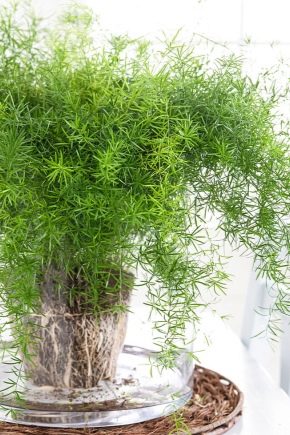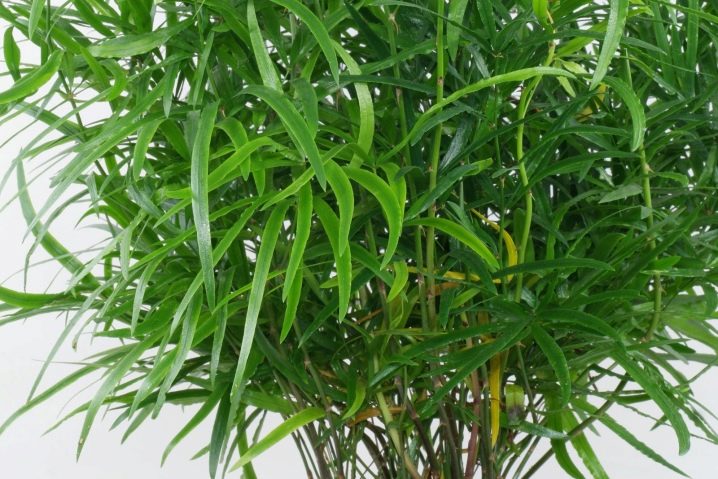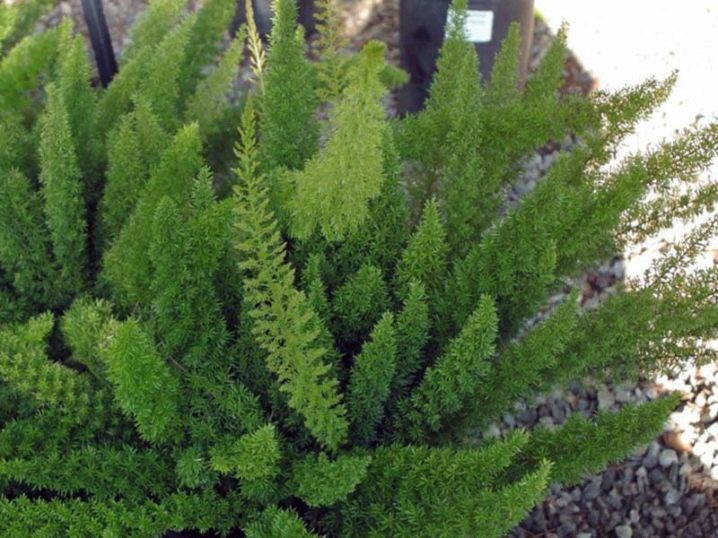Types and varieties of asparagus

The unpretentious asparagus can be seen in almost every home. It decorates the home, creating a sense of seclusion in a cool corner of the forest, where it is always calm and fresh. How different types of asparagus look like, how to care for a plant and decorate the interior with it, read this article.

A brief description of the appearance
Asparagus is an evergreen plant growing in India, Japan, Egypt, and the USA. It is a branched perennial shrub whose leaves do not look like ordinary ones. Instead, the cladodia flower has modified leaves, narrow, small, scaly, like needles. To many, asparagus resembles the bizarre algae "fucus" or the usual "cuckoo flax", which belongs to the bryophyte family and grows in our forests. In fact, asparagus is a plant from the Asparagus family.
The stems of the plant are long - from 1.5 m, often bare. Branching shoots are abundantly covered with lush ornamental greenery, for which flora lovers appreciate the plant. Asparagus grows not only as an upright shrub. There are its ampelous types - lianas with thorns for support. Asparagus flowers are small, solitary, or clustered. They have a white or cream color and a peculiar smell that not everyone likes. The fruits that emerge after flowering are red or yellow and are poisonous.


Varieties
In nature, there are more than 300 species of asparagus. The most beautiful and unpretentious of them decorate our homes.
Crescent or falkatus
The stem of the plant is covered with thorns that resemble a sickle - hence the vine got its name. It grows unhindered, climbing with thorns on any surface. The length of the shoots reaches 4 m, the height is more than 1 meter. The plant blooms with small delicate cream flowers, collected in inflorescences.

Plumosus
Another name for the plant is pinnate asparagus. The ends of the lush shoots are shaped like luxurious ostrich feathers. The stems, bare in the middle, branch strongly, so the bush turns out to be voluminous. The shrub blooms with small white flowers that have a specific smell.

Sprenger
Branched creeping vines cling to rocks, trees, and soil. The stems of the plant are thin and bare, up to 1.5 m long, inclined downward. Bunches, collected from shoots with short and sharp thin leaves, create a lush green cloud.

Racemose
Easily masters any obstacles, the thorny flower grows up, and then lowers its shoots with subulate cladodia, collected in the form of bunches. Pink inflorescences are collected in tassels, from which this type of asparagus got its name.

Dense-flowered
The plant creates many drooping shoots up to 50 cm in length. The greenery is bright and lush, like the finest needles, forms a very beautiful bush, and the flowering is extremely abundant and long-lasting for this culture.

Pyramidal
Pyramidal asparagus can easily be mistaken for a juniper. Shoots are erect, up to 1.5 m in height, covered with very soft and delicate needles.


Asparagus
This handsome man has large leaves, bright green and shiny. It can be confused with regular ivy. It grows like a liana, requires support. With its help, you can create a whole hedge or phytowall. The flowers of the plant smell like orange.

Medicinal or ordinary
Carefully grown in plots and summer cottages as a horticultural crop. The bush is magnificent, lush, fluffy, very decorating the landscape. The shoots are soft, with rather long cladodes, are used by florists in bouquets, are used for food and for the manufacture of medicines. Reach up to 1.5 m in length.

Setaceus
It has sprawling fluffy, highly branching shoots with thin short cladodes, growing in several tiers. He loves light very much, so it grows better in hanging pots on the windows.

Virgatus
This type of asparagus is also loved by florists for its abundant green mass, necessary for creating compositions in a rustic, eco and massive style. The needles are soft and long, the shoots retain their freshness for a long time after cutting.

The thinnest
This asparagus has long, graceful shoots. The variety can be confused with pinnate asparagus, but the main difference between thin asparagus is miniature fragile needles. The greenery of this flower is like a transparent and light green lace.


Umbelatus
This is another favorite of designers and florists. The branches of the plant are dense, have beautiful curves, the greenery is very dense, gathered in frequent double bunches, which resembles the branches of a luxurious Pitsunda pine.

General rules for home care
A tropical inhabitant, asparagus feels great in our apartments. All types of this plant are unpretentious. Seeing a green handsome man with curly branches in a store, a lover of room flora simply cannot pass by. When purchasing asparagus, the first thing to do is transplant the plant.
Transfer
The soil in which the plant is sold is for transportation only. Upon arrival home, the asparagus should be transplanted following these instructions:
- free the roots of the plant from old soil;
- pour 1/3 of the drainage into the pot - expanded clay;
- put moss on the bottom - sphagnum;
- the soil is suitable for decorative deciduous plants;
- fill in a 1/2 pot of soil and carefully place the plant inside;
- gently brush the remaining soil along the edges of the container and slightly around the base of the flower;
- water the plant with settled soft water.



Young asparagus are transplanted every year, as they grow rapidly. The pot needs to be taken a little more than the previous one. Adult specimens are transplanted every 3 years. You can make up the mixture for the plant yourself. To do this, you need the following ingredients:
- river sand — 1/4 part;
- leaf land - 1/4 part;
- humus - 2/4 parts.

Lighting
In its homeland, asparagus grows under the spreading crowns of tropical forests, where the light of the sun enters softly and unobtrusively. Direct burning sunlight is an unfamiliar and undesirable phenomenon for asparagus. There are asparagus species that are more and less light-loving. The plant will thrive on east and west windows. In a room where the windows face south, the flower can be placed away from the window, in an area where the light will be diffused. Here the flower will be in the comfort zone and will perfectly fit into any interior.
With the onset of winter, the plant begins to lack sunlight. The stem of the plant stretches towards the light, becomes naked, and leaves feathers remain on the crown. The plant needs to be moved to a brighter and cooler place. If the sun is not hot yet, the pot can be placed on the south window.

Temperature
In summer, the temperature in the room should not be higher than + 22 + 25 degrees. Otherwise, the plant begins to dry out and takes off its beautiful fluffy outfit. Asparagus loves fresh air and does not mind spending the summer on an open veranda or on a balcony, in a shaded corner, but not in the sun. In the autumn-winter period, when the plant needs rest, it is advisable to move the asparagus to a cooler place with a temperature not higher than + 15 degrees. This will allow him to rest and save energy by the beginning of the new growing season.
Important! It is impossible to keep the plant near the battery. Asparagus leaves will turn yellow and peel off.If this happens, urgently transfer the flower to a cool place, and carefully trim the bare branches. This contributes to the emergence of new shoots.

Watering
Asparagus loves good watering, the soil in the container of the plant should be moist, but in no case wet, which leads to the death of the roots. In the summer, the flower is watered at least 3 times a week. Abundant moisture is not needed for asparagus, and spraying is even beneficial for the plant, especially in summer. It helps to withstand heat and fight pests. In winter and autumn, the crop is watered as needed: if the soil has dried out in a pot to a depth of at least 3 cm, it's time to water the flower. In the spring, when fresh young greens appear on the asparagus, the amount of watering is gradually increased.
Important! Be sure to drain excess water from the sump after watering. This leads to waterlogging of the earth and decay of plant roots.

Fertilizers
From the beginning of the growing season, the plant is fertilized more often. In summer, top dressing can be applied once a week. Any liquid balanced fertilizer will work for asparagus. The first years of life, the plant especially needs nitrogen and calcium:
- nitrogen stimulates the growth of shoots, helps to build up a gorgeous green mass for asparagus;
- calcium develops the skeleton and strengthens the plant's root system.


During flowering, it is good to feed the flower with phosphorus-potassium fertilizers. Suitable fertilizers for asparagus - fertilizers for ornamental plants:
- "Rainbow";
- "Effecton";
- Agricola;
- "Hyacinth"
.



Reproduction
You can propagate the plant in the following way:
- dividing the bush;
- seeds;
- cuttings.
By dividing the bush
This method is easily propagated by adult plants over 4 years old with a powerful root system. This is done in the spring during plant transplantation. The rhizome is cut into pieces, trying not to damage much. The affected roots and tubers are sprinkled with activated carbon, transplanted into pots.


Seeds
It is not difficult to grow a flower from seeds. Landing is done in late February - early April in warm wet sand or peat. Containers with crops are kept in a dark place with a temperature of no higher than 25 degrees. To maintain moisture, the soil is sprayed. The sprouts will appear on the surface in 3-4 weeks. Boxes with seedlings are transferred to the light. Young plants are planted in separate pots after 4 months, when the sprouts are stronger and their height will be more than 50 cm.


Cuttings
Cuttings are cut at the end of March. Rooted in a moist substrate and placed in a greenhouse: the box is covered with foil or glass. Airing and spraying the plants must be carried out daily, otherwise they may rot. With proper care, the plants will take root after 3 weeks. You can plant them in separate containers.


Examples in the interior
After the hustle and bustle of the working day, it is natural for every person to return home and relax. Indoor flowers not only decorate the interior, but also help create an environment conducive to relaxation and relaxation. Luxurious asparagus greens are soft, patterned and lush and are great for this purpose. Fluffy shoots of a plant can decorate not only windows. They fit perfectly into any environment and allow you to make bright accents in the interior.
- The phytowall with light asparagus feathers looks very beautiful and original.

- Phyto-paintings are in trend, small corners of wildlife on an ordinary wall.


- The decor of the room, which is decorated with thin graceful shoots, looks original.


- Vertical landscaping can also be created in the bedroom.


- The flowerpot of an unusual shape is a striking detail of the interior.

- Asparagus will harmoniously fit into the atmosphere on the veranda or balcony.

You can place asparagus on bookshelves, shelves. You can put a voluminous flowerpot with a flower on the floor. In any location, contemplation of this amazing creation of nature will give you pleasure.
About asparagus: species, care and breeding, see the next video.



























The comment was sent successfully.